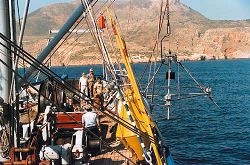Technical Capabilities of FORACS
The number of sub-systems and systems that can be tested at NATO FORACS has grown continually over the years. Currently it includes, but is not limited to, fire control and surveillance radars, sonars, Electronic Support Measures (ESM), Antenna Radiation Patterns (ARP) (especially important when operating ship's boats in a Maritime Interdiction Operations (MIO) or counter-piracy role), periscopes, navigational systems, lasers and a Link-11 capability. Parameters that can be measured include bearing, range, geospatial, timing, and frequency accuracies, utilizing both static (alongside) and dynamic (underway) checks. Data capture and analysis facilities have enabled systems analysis to evolve, thereby permitting testing of significant portions of the combat system as an integrated whole.
The capabilities of the FORACS ranges are continually updated to reflect the need to work with more modern ship systems design, evolving and more ambitious testing regimes and obsolescence management. This is undertaken on a routine formal planning basis, drawing together and prioritising the requirements of member nations. Tracking

Model of FORACS Tracking System |
A NATO FORACS range is equipped with optical and Differential GPS tracking instrumentation which is capable of fixing a reference point on the ship within 1 meter of accuracy.
The ship's general plans are used during the dockside phase to determine the location of each sensor on-board the ship relative to the FORACS reference point. A theodolite aligned to the centerline of the ship tracks an optical target ashore to provide a measurement of ship's heading to better than 0.03 degrees depending on weather conditions. From the measurements above, the x-y location and orientation of each shipboard sensor are calculated.
Navigation Systems
Accuracies of shipboard GPS and other navigation systems are tested against the data (approximately 1 meter) generated by the FORACS tracking systems.
Targets

Model of FORACS Targets
Acoustic
- Active sonar range errors are measured at dockside using a portable sonar transponder (500 Hz to 50 kHz).
- Active sonar range and bearing performance on-range is measured using bottom-mounted transducer arrays connected to shore-based electronics by underwater cable. The frequency range is from 2 to 50 kHz; maximum pulse length is 10 seconds. In addition to synthesized CW and FM pulse signals, an echo repeater mode is available whereby an actual sonar transmission may be captured, precisely delayed, and re-transmitted. A Doppler offset may be added if required.
- Mine hunting sonars up to 600 kHz can be tested dockside using a High Frequency test set capable of precise range delays. Dynamic bearing and range accuracy is tested using bottom-mounted mine shapes and acoustic reflectors.
- Passive sonar bearing accuracy is tested with the underwater targets connected to a noise generator - filter - amplifier ashore. Noise signals are available throughout the range of 400 Hz to 50 kHz with the width of the noise bands adjustable through appropriate filter settings.

Installation of a FORACS Acoustic Target
Click on picture to enlarge
Electro-Magnetic
- Radar transponders generate targets in the frequency range
1 to 18 GHz and 26 to 40 GHz, with pulse modulation capability equivalent to the transmitted radar signal (maximum spectral band width: 30 MHz).
- Radar reflectors are also used for passive electro-magnetic targets.
- Electronic Warfare Support Measures (ESM) signal sources provide a computer-controlled ESM target system which is capable of transmitting up to eight different signals simultaneously in the band 2 to 18 GHz.
Electro-Optical
- An optical prism reflector target is used for range accuracy tests of lasers.
- Infrared sensors are tested against a high intensity lamp target, which is also used for tests of TV tracking systems.

NATO FORACS Norway Range Buildings and Dockside Facilities

